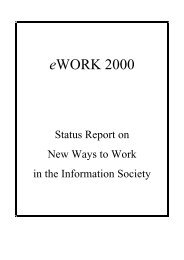1996 - European Telework Week
1996 - European Telework Week
1996 - European Telework Week
- No tags were found...
Create successful ePaper yourself
Turn your PDF publications into a flip-book with our unique Google optimized e-Paper software.
<strong>Telework</strong> 96<br />
2.4. Legal, Organisational and Management Issues in <strong>Telework</strong>. New Ways to<br />
Work in the Virtual <strong>European</strong> Company<br />
2.4.1. Flexible employment<br />
<strong>Telework</strong> can help introduce new flexibility into employment. The removal of obstacles<br />
inhibiting teleworking activities is essential for the creation of "virtual businesses," with<br />
fully integrated activities, which could be distributed throughout the <strong>European</strong> Economic<br />
Area, thus supporting the consolidation of the <strong>European</strong> internal market. In order to<br />
complement the stimulation of transborder telework through demonstration projects, indepth<br />
analyses have been carried out with respect to management, labour relations and<br />
legal issues. The main recommendations of these analyses by the COBRA, ATTICA and<br />
PRACTICE projects are summarised in this report.<br />
<strong>Telework</strong> can help introduce new flexibility into employment. The main areas of<br />
potential application are currently in data and text processing (50%); programming<br />
(40%); writing, editing, translating and accounting (30%); secretarial functions<br />
(20%); marketing and training (15%) and research/consultancy activities (14%) 11 .<br />
The term teleworking covers a wide range of activities: it includes home teleworking,<br />
satellite centre working, (where an office provides the means for one firm's employees to<br />
work at a distance from the firm), telecentre working, (where an office is shared by<br />
several firms), distance group working and teleservices provision as in telesecretariats,<br />
and telemaintenance.<br />
The main areas of potential application are currently in data and text processing (50%);<br />
programming (40%); writing, editing, translating and accounting (30%); secretarial<br />
functions (20%); marketing and training (15%) and research/consultancy activities<br />
(14%) 1 .<br />
2.4.2. Customer Driven Business Organisation<br />
Since the beginning of the 1990s, a revolution in business organisation has been<br />
sweeping Europe. Corporations have been adopting a new US management technique<br />
called business process re-engineering (BPR). BPR as a way of re-organising business<br />
around processes rather than functions. This leads to a more focused customer-driven<br />
organisation and which is also usually accompanied by the contracting out of what are<br />
called non-core activities.<br />
Since the beginning of the 1990s, a revolution in business organisation has been<br />
sweeping Europe. BPR is a way of re-organising business around processes rather than<br />
functions.<br />
BPR produces greater flexibility, which is achieved through the use of part-timers,<br />
associates and outsourced workers; whose membership is flexible and temporary. A key<br />
result is that companies can react to external pressures more rapidly, bringing in skills at<br />
11 <strong>Telework</strong>: Penetration, Potential and Practice in Europe, final report of project TELDET, July 1995<br />
- 38 -








